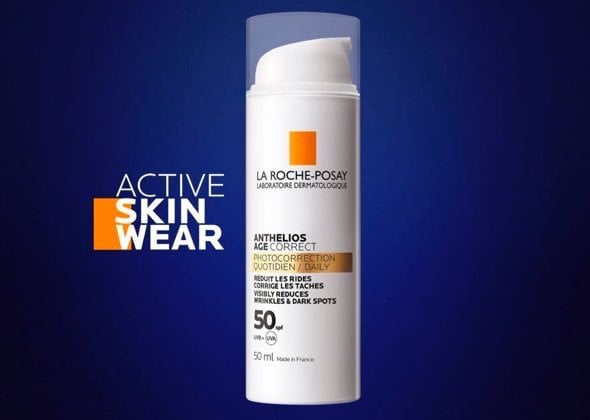POLLEN ALLERGY
What is pollen?
Pollen grains are tiny protein-studded structures released by plants and trees at various times of year. Skin-prick testing will pinpoint the pollen that is causing your allergic skin reaction. The worst offenders? It depends on where you live, but Timothy grass and beech tree are two of the most tested-for pollens.
Symptoms of pollen allergy
Pollen allergy causes problems such as conjunctivitis, hay fever, pollen-induced asthma.
But did you know that pollen also causes skin allergy? It disrupts the skin’s protective barrier, allowing it to act as a direct skin irritant and allergen1?
What you can do about pollen allergy
Your doctor can advise you on medications such as oral anti-histamines, eye drops and inhalers to help with pollen allergy symptoms.
For sensitive skin, consider a barrier cream with an absolute minimum of ingredients to reinforce your skin barrier.
COSMETICS
ALLERGY
What is make-up allergy?
Some make-up and skin-care products contain ingredients such as parabens, lanolin, fragrances, and certain colorants, that can trigger skin allergy to make-up. Another top offender is nickel, which many people don’t realise is found in certain cosmetics.What are the symptoms of cosmetics allergy?
There are many different types of allergic skin reaction caused by cosmetics. Nonetheless, the key symptoms are itching and burning sensations.
What you can do about make-up allergy
The good news is you don’t have to clear your bathroom shelves! If you have allergic-type skin, dermocosmetics are your go-to skincare, so do pay a visit to your local pharmacy.
Organic and natural products can sound like the safe option, but they may contain major allergens such as essential oils and fragrances.
If you are nickel-sensitive always look out for the label“nickel-controlled” on packs. Ask your allergist about patch-testing to track down your personal triggers.
Click HERE for more information on how to avoid reactions to cosmetics.
DUST MITE
ALLERGY
What is dust mite allergy?
Here’s where things get a little creepy-crawly! The house dust mite, or Dermatophagoides, is a microscopic arachnid that feeds on skin cells and is commonly found in bedding and carpets. The droppings and exoskeleton (that’s body armour for insect-type creatures) of these mites can cause allergic reactions including skin allergy.
What are the symptoms of dust mite allergy?
Allergy to dust mites can cause conditions such as allergic rhinitis (inflammation of the inside of the nose), asthma, and eczema. Skin allergic reactions are also a big issue, as dust mites release substances that break down the skin’s barrier, making it more vulnerable to reactions2.
What you can do about dust mite allergy
There are several practical tips worth trying if you or a family member has house dust mite allergy:
- Use anti-dust mite bedding.
- Wash bedding weekly and launder towels and bath mats after 2-3 uses. Use hot washes at 60°C to kill mites and always dry thoroughly.
- Invest in a dehumidifier.
- Air your bedroom for 30 minutes each day, especially in cold and dry weather.
- Keep your home a little cooler: limit heating to 18 or 19°C.
- Minimize dust by removing clutter and vacuuming regularly.
- Opt for hard flooring rather than carpets.
- Consider using home test kits such as the Acarex test® to pinpoint where your home or workplace might be contaminated with house dust mite.
- Strengthen the skin barrier with hypoallergenic dermocosmetics.
FOOD
ALLERGY
What is food allergy?
Proteins in certain foods can trigger an immune response in the mouth or gut that may potentially affect the whole body including skin allergic reactions. Just 8 food types cause about 90% of food allergy reactions3:
- Milk
- Eggs
- Peanuts
- Tree nuts, like walnuts, almonds, pine nuts, brazil nuts, and pecans
- Soy
- Wheat and other grains with gluten, including barley, rye, and oats
- Fish
- Shellfish
What are the symptoms of food allergy?
Food allergy can cause anything from mild itching of the mouth, to skin rashes, to full-blown anaphylactic shock. Since it’s a potentially dangerous form of allergy, an allergist consultation is in order.
What you can do about food allergy
Your allergist will use specific tests to pinpoint the causes of your allergy, as well as offering advice on eliminating it from your diet and the need to carry an Epipen.
Watch out for “hidden” sources of allergen: baked goods often contain egg and nuts, while tinned tuna and hotdogs may contain milk protein!
Could your 5-a-day be affecting your allergies?
GLUTEN INTOLERANCE,
SOMETIMES CALLED GLUTEN ALLERGY
What is gluten?
We've made a separate entry for gluten because, although it is found in foods, there is a lot of common misunderstanding about sensitivity to gluten.
Gluten is a group of proteins found in grains such as wheat, barley, rye, and oats. It is also used in various products to give them a more elastic or “chewy” texture – such as doughs (and even Play-Doh!).
What are the symptoms of gluten intolerance?
In predisposed individuals, gluten can trigger different conditions that are not actually allergies per se. These include Coeliac disease and non-Coeliac gluten intolerance. In some rare cases, it is also possible to have a genuine gluten allergy.
What you can do about gluten intolerance
Your doctor can advise you on how to tailor your diet to your Coeliac disease, gluten intolerance, or gluten allergy. Many foods do not contain gluten at all, and the good news is that there are also more and more substitute products, such as gluten-free bread, available on the market today to make a gluten-free life easier.
DRUGS (MEDICINES)
ALLERGY
What is drug allergy?
Drug allergy is an allergic reaction to medications prescribed to you by your doctor or bought over the counter. You can be allergic to any medication, but certain medications [CERTAIN MEDICATIONS] are frequently implicated as causes of skin allergy:
- Penicillin and related antibiotics
- Sulfonamides (“sulfa drugs”)
- Anticonvulsants (epilepsy medications)
- Aspirin, ibuprofen and other nonsteroidal anti-inflammatory drugs (NSAIDs)
- Chemotherapy drugs
What are the symptoms of drug allergy?
Like food allergy, allergic reactions to drugs range from mild to serious. You may get a skin rash or hives, itching all over the body, breathing problems such as wheezing, swelling or even life-threatening anaphylaxis.
What you can do about drug allergy
If you have had a drug allergy, you should see an allergist for advice. It is essential that you inform every doctor you see of your drug allergy. Always read the information leaflet that is included in the packaging of your medicines. A medical alert bracelet is also a good idea so healthcare professionals will always know about your allergy even if you can’t tell them.
LAUNDRY DETERGENT
ALLERGY
What is laundry detergent allergy?
We all know what laundry detergents are, but what allergens do they harbour? Essentially, they may contain fragrances (fresh and breezy isn’t always your best friend!), enzymes, and irritants such as sodium lauryl sulphate.
What are the symptoms of laundry detergent allergy?
Allergy to laundry detergent can cause skin allergic reactions such as eczema, contact dermatitis, and urticaria (hives). It can also cause itchy eyes and wheezing.
What you can do about laundry detergent allergy
If you experience itchy skin, or any of the symptoms described above, try changing to a hypoallergenic and fragrance-free laundry detergent. Remember that your baby spends a lot of time snuggled up against your clothes and bedding, so this is essential if your little one has sensitive skin.
Click HERE for tips on allergy-friendly laundry.
SKIN ALLERGIES
WITH DOGS AND CATS
What is pet allergy?
Fur, skin cells (dander), and saliva from our four-legged friends contain proteins that can set off allergic reactions such as skin allergies with dogs and cats.
What are the symptoms of pet allergy?
Pet dander and saliva can trigger most common allergic manifestations, such as allergic rhinitis (inflammation of the nose), conjunctivitis (inflammation of the eyes), asthma, and eczema.
What you can do about dog and cat allergy
See an allergist to confirm the cause of your allergy. They will be able to advise you whether you are a candidate for desensitization therapies or “allergy shots.” It may also be possible to manage your symptoms with medications such as anti-histamines. However, if you have severe skin and other allergies with dogs and cats, furry and fluffy friends may not be for you
MOULD
ALLERGY
What is mould allergy?
Moulds are fungi that can grow in damp places in our homes or work places. They release thousands of microscopic spores with the potential to trigger allergy.
What are the symptoms of mould allergy?
Since the spores are airborne, they cause symptoms similar to pollen allergy: itchy eyes, sneezing and wheezing, but also dry and scaling skin4.
What you can do about mould allergy
Seeing an allergist is important to establish that mould truly is the cause of your symptoms. If it is, consider following the guidelines from the Environmental Protection Agency. In a nutshell, it’s all about reducing moisture to a minimum.
FRAGRANCE
ALLERGY
What is fragrance allergy?
Over 2,500 fragrance ingredients are used in perfumes and a range of personal or home care products. They can sometimes cause skin irritation or allergic reactions. Key examples frequently tested for include cinnamal, geraniol and eugenol5.
What are the symptoms of fragrance allergy?
Fragrances may cause reactions typical of airborne allergens such as itchy eyes, sneezing, and a worsening of asthma. They can also cause a range of allergic skin reactions, as well as headaches in some people.
What you can do about fragrance allergy
Fragrances are difficult to avoid due to their widespread use, but practical measures such as good ventilation should help. Choose fragrance-free alternatives wherever possible. When it comes to skincare, the key is to source fragrance-free products that are well-tolerated for allergy-prone skin.








